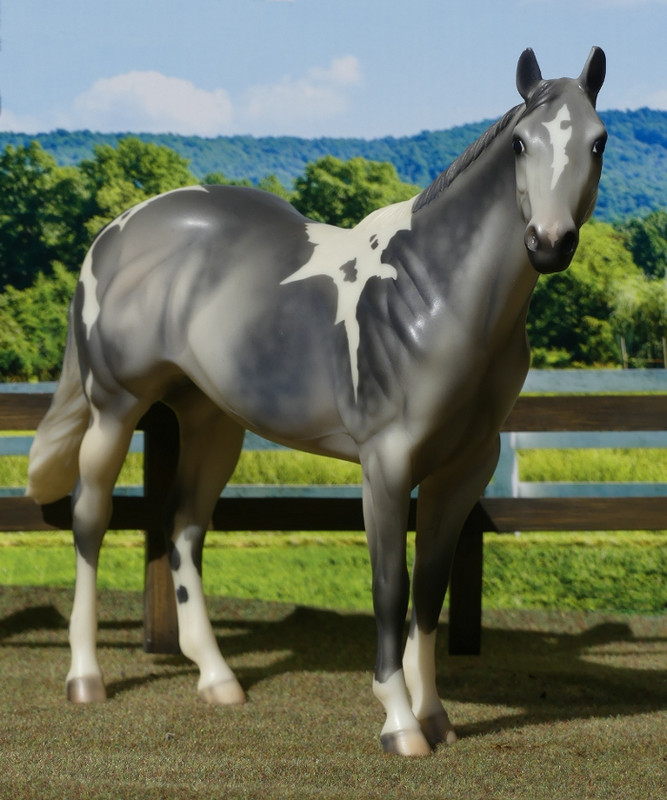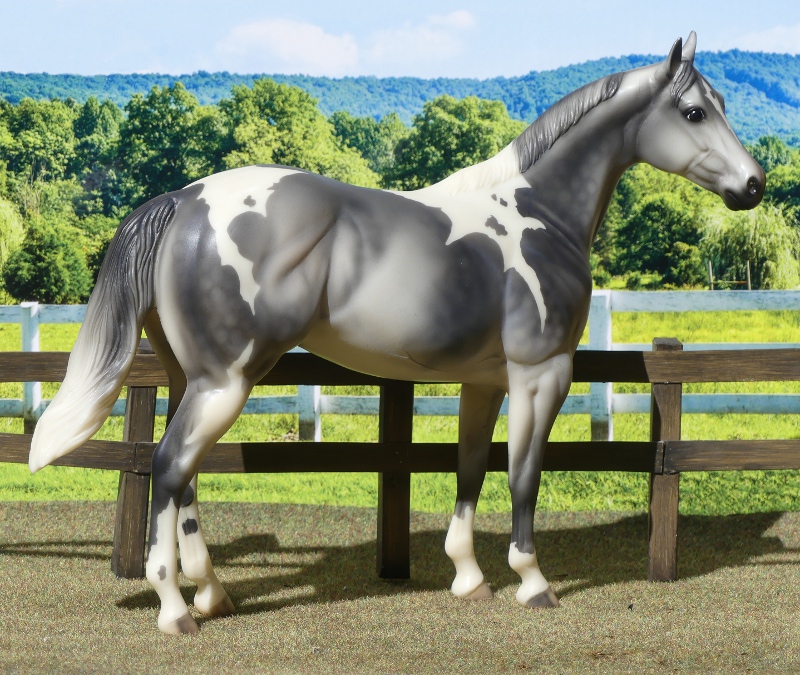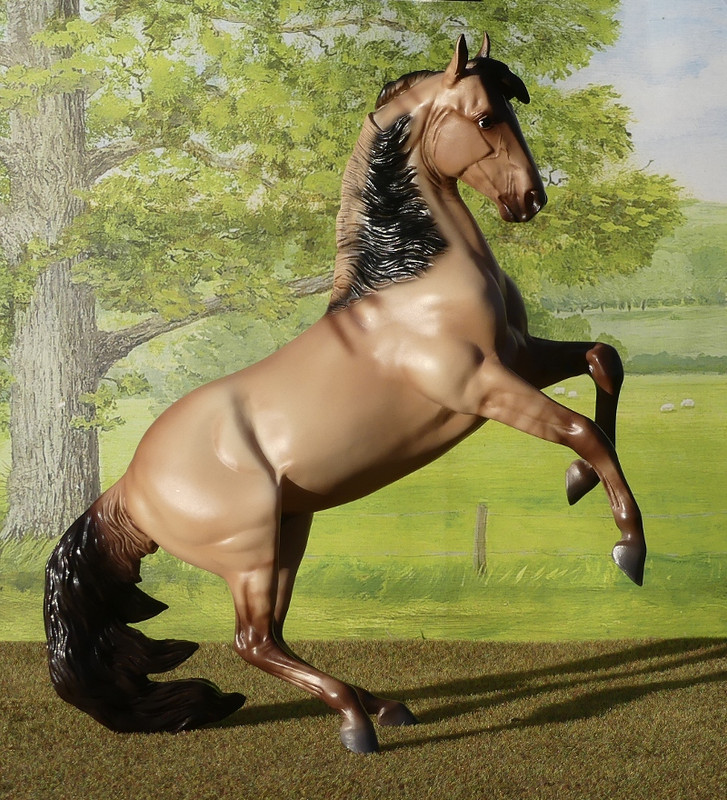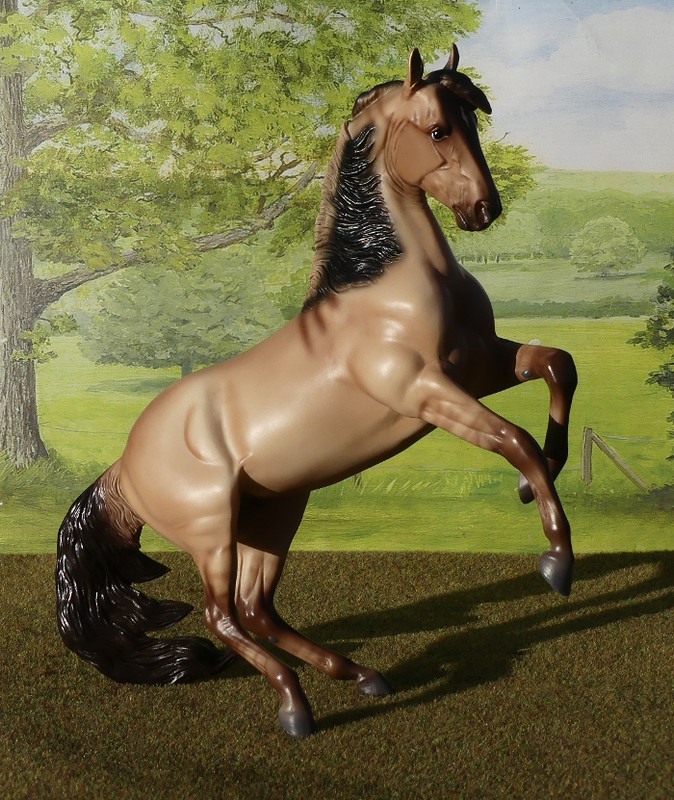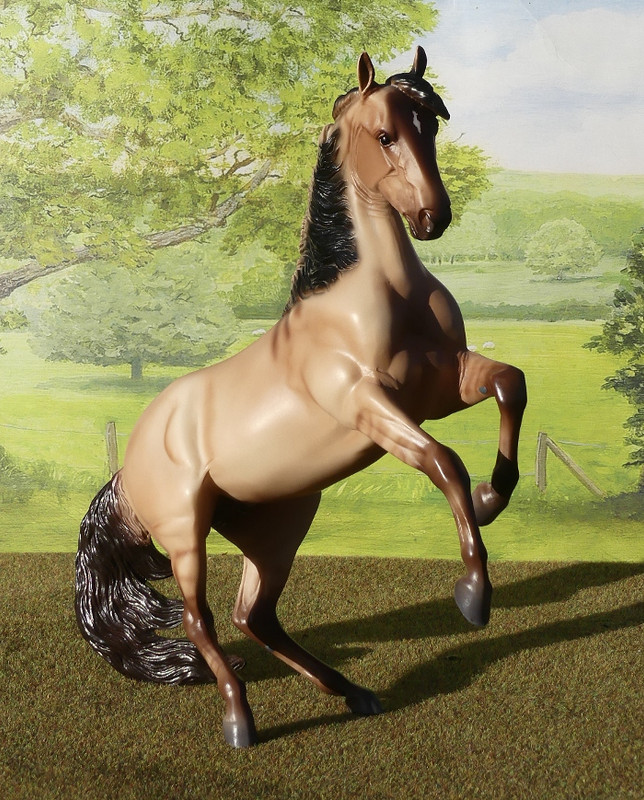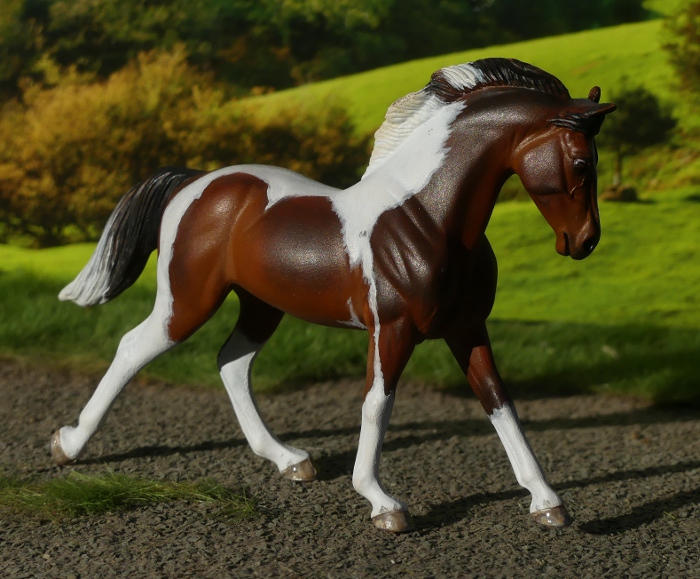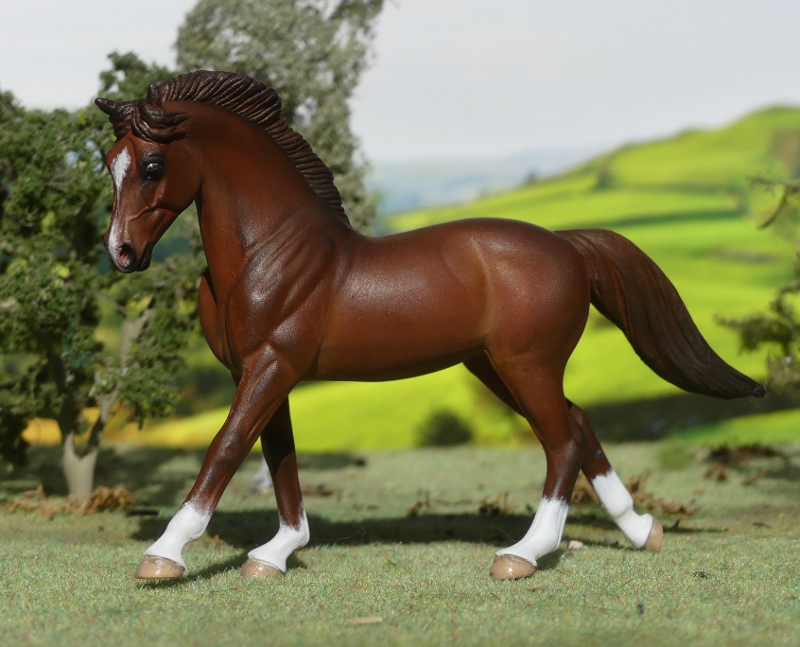Well, the pictures are out for the Breyer 2020 regular runs, and I thought now I've got a bit of time to muse on each one, it'd be nice to do a little mini review of my first impressions, make a note of what's on my wish list and what's not, then look back and see if any of my opinions change as the year progresses and we get the first 'real' photos from collectors, or chance to see and handle the models themselves on trade stands.
All the releases so far are up
here, a dedicated New for 2020 page on the excellent Identify Your Breyer site.
So, let's have a look through them. They're a bit muddled at the time I write this, with some Collector's Club glossy exclusives taking up the top spot where we'd usually see the regular runs first, but scroll a bit and you get to the first model that'll be general release - Stingray.
At first glance I thought she was a flaxen chestnut on the Wyatt/Babyflo mould, and was questioning the logic of doing two regular run chestnuts in a row, but then I googled the real horse to investigate what seems to be an interesting dark blotch on her side, from flank up toward her back. The marking is there, but the horse is very much
not a chestnut after all - just do a quick search on 'Stingray barrel racing' and you'll see plenty of photos of a very pretty sooty/chocolate palomino mare. My own pony is this colour, so I know it well! It's curious that the model and the real horse don't seem to match at all; I'm wondering if the lighting or colour balance in the promo shot is misleading, as I can't believe they struggled to find the right pigments for the paint and just did it ginger! I didn't buy Bablyflo because I thought her colouring was a bit on the plain side, so I think I'll get Stingray instead.
Next on the page we see The 'Gangsters', a pair of skewbalds on the Galiceño and Pony of the Americas moulds. Neither of these moulds do anything for me, I'm not a fan of the older sculpting style and although I'm sure the real ponies are great characters, the models don't appeal to me.
The next model down is the Connemara Mare mould, most recently seen as Banks Vanilla. Again I had a reason to avoid the Vanilla release, it screamed
WRONG MOULD! for a show-ring champion pony, where manners and rideability matter just as much as anything else. I just didn't like that they chose a mould of a wild-looking temper strop or playfight for a portrait of a show pony, and even though I might've overlooked that and ignored that it was a portrait model if I really really loved the colour, the white grey was plain enough that I never did get tempted.
This time, however, they've used the mould for a Sable Island Horse, a feral pony breed which lives a natural life away from all human interference. They're not
meant to look tame, and so the mould is a much better fit! I like the colour too, especially the paler shading round eyes and muzzle, and the sun-faded tail, so I'm quite looking forward to being able to add this mould to my collection this time round.
The fourth on the list is apparently 'The Ideal Series' American Quarter Horse. Breyer's site explains that it's based on a famous artist's portraits of the ideal example of various horse breeds, and as he's started with the QH, I'm going to assume he's mostly famous in the USA, the way horsey people in the UK are more likely to know artists like Stubbs and Munnings.
Anyway, the Ideal QH is a chestnut Geronimo, that mould which always makes me think Breyer badly wanted an equivalent of the Peter Stone Ideal Stock Horse which is so popular, so they commissioned
something like the ISH but not quite. Sadly that's exactly what I always see it as : the one like the ISH but not so nice. The head's not as good, not as friendly-looking, I can't put my finger on what's up - the eye's maybe too high, too far forward perhaps, the head too small as a whole, or too wedge-shaped? It could be a little of all of these added together! Maybe one day they'll do it in a colour which changes my mind, but a simple chestnut is not that colour - not for me thanks!
The next release is a bit complicated to describe, but easy to review -
I hate it.
There's five different models, each representing a different era of Breyer moulds plus a bonus rare Chase Piece, and when you order one, they're randomly shipped - you don't know which you'll get.
This mystery game may be all well and good with Stablemate Blind Bags, where you're risking £3.99 if you get a model you don't like much, and maybe wasting a few extra £3.99s on duplicates if you want to keep searching for the one you're after, or to complete the set.
Now try thinking that about
fifty pounds.
You send off your £50, and you get one of five models. Maybe you like it, but maybe you hate it. Maybe it's a mould you don't want, or a breed you've no interest in. Maybe you have that one already. With £3.99 models, you can shrug it off, a disappointment but no big deal. You can always buy another one, even a child saving up pocket money can keep trying.
But no-one's going to say 'oh well, it was only £50' and order another without minding. That's just
not throwaway money, not something you can lose without flinching. That's a hefty amount to risk on not knowing which horse you'll get. And nobody's going to be cheerfully content wasting a couple of hundred pounds trying to chase down a full set of these models. Sure, you can sell your unwanted ones on the second hand market, and you're
certain to find buyers who want the sale without the risk, but the point is, the initial outlay is just too big to make it a fun gamble, unless you just happen to like all the models and don't care which you end up with.
I like the Andalusian so so much, his colour suits the mould, is really well done, and not something we've had on any other regular run before. I'd buy him outright if he were just, you know,
buyable.
The chase pinto is nice enough that I'd not be too disappointed if I got him instead.
The saddlebred? Ever since we first saw the photo of this mould I've been thinking the body is very well done but the tail is kind of freaky, and I'd want to see one in person before I can really tell what I think of it. Would I be disappointed if I got that one? No, I can overlook a bizarre tail if I like the rest of the horse.
The Fighting Stallion and Indian Pony, though, I don't like those moulds. I don't
hate them and think they're hideous, just the sculpting style isn't my cup of tea, and I wouldn't buy them by choice, nor want them in this lucky dip gamble. So with an unknown ratio of Chase models in the mix, that leaves me with a slightly more than half chance of getting a model I'd like enough to keep, and a slightly less than half chance of getting a model I'd have to sell (including the hassle of setting up a seller account on Ebay) to get my money back and try again.
That's
not a game I'm going to play for £50 a go, Breyer, so I'll leave this 70th Anniversary Assortment well alone for now, and hope that maybe one day the Andalusian might pop up on Ebay, if someone else receives a duplicate or a disappointment and wants a new home for him.
Next on the page comes a chestnut Flash morgan, Avatar's Jazzman. I like him but not enough to buy, as I feel like I've said a lot on this post already his colour just strikes me as a little bit plain - don't get me wrong, there's
nothing wrong with a good basic chestnut, and he has rich shading, nice highlights to his mane and tail, and good crisp socks (an unmasked fuzzy sock is one of my pet hates!). If I didn't already have a bay, a dun and a couple of customs on this mould I'd probably have put him on my 'maybe' list, but with shelf space an ever-present problem for my herd, and Trad prices rising year on year, I just can't have All The Models anymore and it's the plainer, less inspiring ones which get left out.
Last regular run Traditional, Airiella and her foal Favory Airiella. I'd said a while ago that it struck me as odd that Breyer had got this Lipizzaner mare and foal mould pair but not released them in a Lipizzaner colour yet - and here they are! Despite the wait, this set's only a 'maybe' for me, as the foal's really similar to the 2019 Hackney one I've already got, and I'm not 100% sure about the fleabites on the mare. Cedric (Showjumping Warmblood) from a few years ago had sweet subtle speckles which looked natural and pretty, where this looks a bit spattery, and maybe standing out because her specks are brown paint but her leg shading is grey. Fleabites are the horse's body colour, left behind in the greying process, so if she was bay before greying out, then the dots would be brown on her body and black on her legs. If she was chestnut before, then her speckling would be brown all over, but her leg shading ought to be brown-toned as well. It might look less jarring in person, especially if the speckling is softer, so before adding to my wishlist, I'd want to see one myself - or at very least in real collector photos rather than the promo shot, which is often the prototype model and not one picked out of the actual production run.
On to the Classics...
First up, the Horse of the Year for 2020, and it's a sleek, stylish, and detailed new morgan mould, with a great colouring and a very well painted face. Again, this may well be the prototype and the models from the production line might not live up to the initial photo, but from what I can see here, it looks like a possibility for my herd, I'm rather low on morgans in general and would happily have a handsome new classic addition when the majority of my models are Trad or Stablemate scale.
Next we've got some horse and foal sets, I haven't gone for these in the past and again there's no combination which shouts BUY ME on first look, the grey TB with a chestnut foal is the only one which might perhaps tempt me later.
The decorators I'll just skip past, I don't collect these so reviewing is best left for people who are into them!
Now Stablemates!
The first SM model we see on Identify Your Breyer is a rainbow clearware unicorn, but check out Breyer's own page for 2020 models, and
this release is actually a set of 5 blank clear unicorns to paint yourself. And hmmm, I think I might get a set of these - snip and file off those horns, and you get a really good selection of new(ish)-mould bodies : Magnolia, a Mini Alborozo, a walking thoroughbred, the new standing warmblood, and what looks like a new SM foal mould. It depends on the pricing, but I'm enjoying painting Alborozos already and looking forward to getting my hands on the walking TB and warmblood for the first time, so this could be a handy way to buy them!
Next on the page, the 'Stable Surprise', which seems to be much the same idea as the blind bag Mystery Horses except they're in a little box this time so you can't squeeze them up to guess the moulds! I like
all the models in the selection, so I'll be trying for the full set and also not minding any duplicates because as I said, I'm looking forward to painting some customs on the newer moulds, so this is the kind of gamble I don't mind taking.
The Mystery Unicorn Foal Surprise is a logical combination of the colourful unicorn blind bags and the mystery foal sets in realistic horse colours, I can see these being popular enough with people who like the decorator-style unicorns but I still wish they'd do one, just
one, model unicorn in a real horse grey with no pearl or metallic or colourful bits.
The last thing I'll review is the Deluxe Horse Collection of SMs (all the items after this are exclusives, accessories, ornaments etc), and this is one I'm very pleased to see!
It seems the old Shadowbox set has been around forever, and although it was great, you can only collect it once and then you're left waiting and hoping they'll change it and give you some more minis to buy. This box might not have quite as many as the Shadowbox, but each one is a nice little horse, good colours on good moulds (I'm still dubious about Darley, but don't mind meeting a weird mould so much when it's part of a set - I ended up quite fond of the last cantering arabian after thinking it looked ugly and strange to begin with, I 'had' to have my first to keep a set complete, and have bought them on purpose since!). My favourite is probably the palomino jumping horse, but there's nothing in there I wouldn't have bought if they'd been single horses to pick and mix, so I'm very pleased with this selction box, and it'll probably be the first thing I order when the 2020s eventually make it to the UK.
So in total, there's two Trads I definitely want to get, and some others I'd consider once I see them in person, one Classic on the maybe list, one must-have SM boxed set, and some surprise SM horse-and-foals to collect til I have them all. This isn't too bad, as it's always a disappointment in the years when there's not enough (or anything!) you're excited about buying, and it'd be too expensive if I ever loved and wanted
all the Trads in any one year, but the amount I've got on my wishlist here is manageable, so I'm happy!
What do
you think of Breyer's selection this time round? Which horses have gone on your wishlist for next year? Do let me know in the comments, it'd be great to know what other collectors think about the 2020 models (and if you're posting a similar review on your blog as well, do leave me a link, I'd love to read it!)



